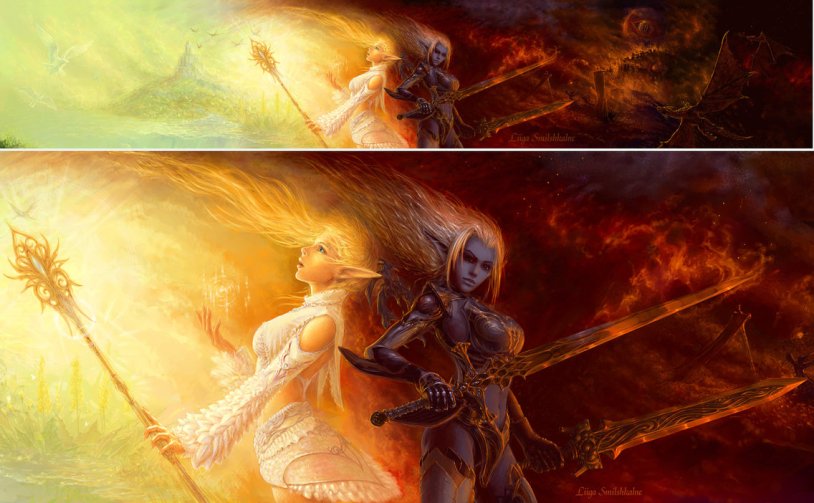Elves are Fairies? Wait, what?
Dökkálfar and Ljósálfar, light and dark Elves; Seelie and Unseelie, Light and Dark Fae…
To begin and in general regarding Elves, this this blog has this to share with it’s readers. “The elves are luminous beings, “more beautiful than the sun,”[2]whose exalted status is demonstrated by their constantly being linked with the Aesir andVanir gods in Old Norse and Old English poetry.[3] The lines between elves and other spiritual beings such as the gods,giants, dwarves, and land spirits are blurry, and it seems unlikely that the heathen Germanic peoples themselves made any cold, systematic distinctions between these various groupings. It’s especially hard to discern the boundary that distinguishes the elves from the Vanir gods and goddesses. The Vanir god Freyr is the lord of the elves’ homeland, Alfheim,[4] and at least one Old Norse poem repeatedly uses the word “elves” to designate the Vanir.[5] Still, other sources do speak of the elves and the Vanir as being distinct categories of beings, such that a simple identification of the two would be misguided.” (1)
At the earliest point it seems there were generally two types of elves:
“Ljósálfar” (“Light-elves”) of Álfheim…In Norse mythology, the light elves (Old Norse: “Ljósálfar”) live in the Old Norse version of the heavens, in the place called Álfheimunderneath the place of the Gods. The idea of the light elf is one of the most ancient records of elves (Old Norse: “álfr” singular, “álfar” plural) preserved in writing, as close to the prototypical idea of the elf as we might get (Nordic mythology preserved an ancient German paganism).
According to the early Nordic source that mentions light versus dark elves, the Nordic Eddas of the 13th century, the light elves are bright and radiant. The Edda “Gylfaginning” by Snorri Sturluson, says that they are “fairer to look upon than the sun” (Arthur Gilchrist Brodeur’s translation).” (2)
Also in Norse mythology, Svartálfar (“Swart-elves” or “black elves”), sometimes considered synonymous with “duergar” (“dwarves”), are subterranean creatures who dwell in the world of Svartálfheim. They may be either benevolent or malevolent. The original Svartalfar worked the forges on the lowest level of the world tree. Their roles and countenance vary throughout Germanic folklore but are sometimes mentioned with Black or Dark skin as a result of working at the forge.
The Dökkálfar (“Dark-elves”) are male ancestral spirits who may protect the people, although some can be menacing, especially when one is rude to them. They are generally light-avoiding, though not necessarily subterranean. (3)
The lines of distinction are pretty vague now but probably was a bit more clear during this ancient time. Then the legends of the Germanic Dwarfs is intermingled with the Dark Elves. On top of that, the Greco/Roman pantheon later had some affect on how things were interpreted into more Forest like spirits for the High Elves as the Dark elves had altered with the Germanic Dwarves. Time passed. Countries and cultures changed. Legends and myths were exported and then reimported with a new interpretation and influence from that culture, then exported again! This happens a few times, including various changes from religion to religion, their appearance, stature and very nature. We have our current classifications or what we think they are now because of this, later writers and romanticism.
So, how does this relate to or have anything to do with Elves being Fairies?
“Fairy comes from the Old French word faerie. The word has been overused to describe a supernatural being….” (4) Early Fae had no wings and had much in common with elves, both having light and dark races. The Fae has history from France and all over Britain. In the Scottish traditions, There were two kinds of Fae, the Seelie or Beings of light and the Unseelie or dark beings. This is also true of the elves, as already mentioned.
In summary, we have the wonderful and rich culture of the Norse mythos to draw from giving us the Elves, and all magical beings in their pantheon. In emphasis, I also repeat how we have seen how they altered with time, culture, religion on top of being, again, exported, altered and reimported several times too so they became all under the umbrella of the “Fairy” title. Now today, we see them as separate beings, thanks largely to, again, popular and wonderful fictional authors.
(1) http://norse-mythology.org/gods-and-creatures/elves/ (I highly recommend you visit this blog packed with Norse myths and information.)
(2) http://en.academic.ru/dic.nsf/enwiki/167247
(3) http://en.academic.ru/dic.nsf/enwiki/179251 (Check out this page/link/site for more info on this, sources and info relating to Scottish Trow and Drow “Elves” !)
(4) http://www.timelessmyths.com/celtic/faeries.html (I highly recommend you visit this blog packed with fairy mythos and history, including types of fairies and from what countries and cultures!)
Moro
(I did not write this article in any way, other than small additions. I simply enjoy sharing pearls of wisdom and beauty from different sources into one source for many to enjoy. If inspired to from there, go to the original sources to discover more!)
Art title: ‘Differences” by artist: liiga @ http://liiga.deviantart.com/art/Differences-87959548

